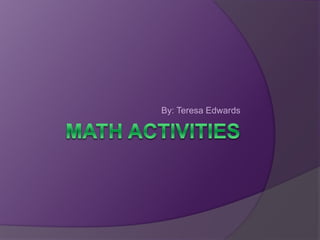
Math activities
- 2. Matching Title: Match Symbols to Groups Method: Interview Skill: The child will be able to count the number of items and then choose the symbol that represents that amount Materials: Objects the child enjoys and cards or paper with numerals on them (1-10) Procedure: Place a certain amount of items on a table and ask the child to count them. Ask the child to choose the card that has the same number as the amount of items they have. Evaluation: Notice which numbers the child can identify and which numbers the child needs help with. Instructional Resource: Charlesworth, R., and Lind, K.K. (2010). Math and science for young children (6th ed.). Clifton Park, NY: Cengage Learning.
- 3. Numbers Title: Finding numbers in our world Method: Observation Skill: Recognizing symbols as numbers instead of letters Materials: Child and the world around them Procedure: Observe the child as they walk around their world looking for numbers. Evaluation: Does the child identify symbols as numbers or letters. Can the child say the number they are pointing to. Instructional Resource: Charlesworth, R., and Lind, K.K. (2010). Math and science for young children (6th ed.). Clifton Park, NY: Cengage Learning.
- 4. Classifying Title: Classifying Colors and Size Method: Observation Skill: Placing items into groups according to size and color. Materials: Legos of different colors and sizes Procedure: Place pieces on table and watch child place them into categories. Evaluation: Notice the methods and reasons the child chooses to place items into the groups. Instructional Resource: Charlesworth, R., and Lind, K.K. (2010). Math and science for young children (6th ed.). Clifton Park, NY: Cengage Learning.
- 5. Comparing Title: Small and large Method: Interview Skill: Noticing the difference in size among similar objects. Materials: Two similar objects in different sizes. Procedure: Place the items on the table and ask the child which object is smaller or larger than the other. Evaluation: Ask the child once and note if they understand the concept after the first time or if you need to repeat the question to the child. Instructional Resource: Charlesworth, R., and Lind, K.K. (2010). Math and science for young children (6th ed.). Clifton Park, NY: Cengage Learning.
- 6. Shape Title: Recognize and recreate shapes Method: Observation Skill: The child can identify a shape and recreate it using different materials. Materials: Picture of a shape and molding material Procedure: Show the child a picture of a shape. Ask them to name the shape and to recreate it using the modeling material. Evaluation: Notice if the child identifies the shape and if they are able to recreate it. Instructional Resource: Charlesworth, R., and Lind, K.K. (2010). Math and science for young children (6th ed.). Clifton Park, NY: Cengage Learning.
- 7. Space Title: Relationships Method: Interview Skill: The child can understand and answer questions about relations using spatial terms such as in, on, under, etc. Materials: Baby doll, bed Procedure: Ask the child to place the doll in the bed. Them move the doll and set it next to the bed and ask the child where the doll in now. Evaluation: After asking the child several questions, notate any spatial words they may need help with. Instructional Resource: Charlesworth, R., and Lind, K.K. (2010). Math and science for young children (6th ed.). Clifton Park, NY: Cengage Learning.
- 8. Parts/ Whole Title: Missing part Method: Interview Skill: The child is able to tell if there is a part missing from an object. Materials: Car with a missing wheel. Procedure: Ask the child if they know which part is missing, Evaluation: Does the child identify the missing part. Instructional Resource: Charlesworth, R., and Lind, K.K. (2010). Math and science for young children (6th ed.). Clifton Park, NY: Cengage Learning.
- 9. Ordering Title: Differentiate by size Method: Interview Skill: The child can identify the size and place them according to height. Materials: Objects of various sizes. Procedure: Present the child with objects in different sizes. Then ask them to put the objects from largest to smallest. Evaluation: Observe if the child can identify the small one from the large one. Then take note if the child can place them from largest to smallest. Instructional Resource: Charlesworth, R., and Lind, K.K. (2010). Math and science for young children (6th ed.). Clifton Park, NY: Cengage Learning.
- 10. Measurements Title: One scoop Method: Interview Skill: Measuring lengths Materials: One object to measure and an object known to the child to measure with. Procedure: Place an object in front of the child and ask them how many q-tips it takes to reach the object. Evaluation: Observe if the child can place the q-tips tip to tail to make the length of the object. Instructional Resource: Charlesworth, R., and Lind, K.K. (2010). Math and science for young children (6th ed.). Clifton Park, NY: Cengage Learning.
- 11. Graphing Title: Graphing Quantities Method: Interview Skill: The child can count the number of objects then recreate it on a graph. Materials: Colored objects in different quantities. Procedure: Ask the child to count the amount of objects. Then ask the child to demonstrate how many there was of each color. In the end ask them which color had more. Evaluation: Observe if the child understands the directions. Watch for process and not product. Instructional Resource: Charlesworth, R., and Lind, K.K. (2010). Math and science for young children (6th ed.). Clifton Park, NY: Cengage Learning.
Notas del editor
- Pointing to # outside